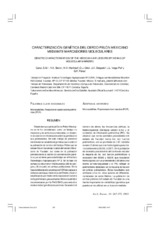Mostrar el registro sencillo del ítem
Caracterización genética del cerdo pelón mexicano mediante marcadores moleculares
| dc.contributor.author | Vega-Pla, J.L. | es_ES |
| dc.contributor.author | Pérez, G.F. | es_ES |
| dc.contributor.author | Ortiz, O.J. | es_ES |
| dc.contributor.author | Martínez Martínez, Amparo | es_ES |
| dc.contributor.author | Canul Solís, M. | es_ES |
| dc.contributor.author | Sierra Vázquez, A. | |
| dc.contributor.author | Delgado-Bermejo, J.V. | |
| dc.date.accessioned | 2010-04-06T11:43:29Z | |
| dc.date.available | 2010-04-06T11:43:29Z | |
| dc.date.issued | 2005 | |
| dc.identifier.issn | 1885-4494 | |
| dc.identifier.uri | http://hdl.handle.net/10396/2831 | |
| dc.description.abstract | Long time ago the Mexican Hair-less pig has been considered as a not improved and not valuable ecotype, nevertheless there are few information about the genetics of their populations. In this work we are determining the genetic variability that could exist in the population of Hair-less pigs existing in the rural areas of the Mexican state of Yucatan, as well as in the population of animals, belonging to the center of genetic conservation of the Agricultural Technological Institute N.2. The experiment was divided in two phases, one on the field and another in the laboratory. On one hand, 102 samples were obtained (69 of blood and 33 of hair) from both populations. In the laboratory the DNA was extracted and was amplified by means of the Polimerase Chain Reaction to study 26 microsatellites recommended by the FAO/ISAG for studies of genetic diversity. The alleles number was analyzed, the frequencies alleles, the hetererozygosity (Genepop version programs 3,1c) and the content of polymorphic information (PIC). We observe as in the population coming from the state of Yucatan all the loci were polymorphic, with an average of 7,07 alleles. We also observe that the loci S0355, S0227 are homozygotic. In the population of animals coming from the rescue center most of the loci were polymorphic with the exception of the S0355 and S0215 that were homozygotic, with an alleles average of 3,65. The PIC also reflect the polymorphism detected in most of the locus in both populations. These results are similar to those obtained with different varieties of Iberian pig. According to this, we can consider that the population of hair-less pigs in the state of Yucatan represents a source of genetic variability that could be of utility in the future. | en |
| dc.description.abstract | Desde tiempos atrás al Cerdo Pelón Mexicano se le ha considerado como un biotipo no mejorado y sin atributos comerciales, no obstante se carece de información sobre la genética de sus poblaciones. En este trabajo se pretende determinar la variabilidad genética que existe en la población de cerdos del biotipo Pelón que se encuentra en las áreas rurales del estado Mexicano de Yucatán, así como en la población perteneciente al centro de conservación genética que se tiene para este biotipo en el Instituto Tecnológico Agropecuario Nº 2. En la fase de campo se obtuvieron 102 muestras (69 de sangre y 33 de pelo) en ambas poblaciones. En la fase de laboratorio se extrajo el ADN de cada una de las muestras por la técnica del Chelex y fueron amplificadas por medio de la reacción en cadena de la polimerasa para estudiar 26 microsatélites recomendados por la FAO/ISAG para estudios de diversidad genética en porcinos. Se analizó el número de alelos, las frecuencias alélicas, las heterocigosidad (Genepop versión 3,1c) y el contenido de información polimórfica (PIC). Se observó que en los animales procedentes del estado de Yucatán todos los loci fueron polimórficos, con un promedio de 7,07, también que existen 2 alelos que son homocigotos para dos locis diferentes (S0355, S0227). En la población de animales procedentes del centro de rescate la mayoría de los loci fueron polimórficos a excepción del S0355 y S0215 que resultaron homocigotos, con un promedio de 3,65 alelos. Así mismo la heterocigosidad y el PIC reflejan el polimorfismo detectado en la mayoría de los locus en ambas poblaciones. Estos resultados son similares a los de otros autores en diferentes variedades de cerdo Ibérico. La población de cerdos pelones del estado de Yucatán son una fuente importante de variabilidad genética que puede ser de utilidad en un futuro inmediato. | es_ES |
| dc.format.mimetype | application/pdf | es_ES |
| dc.language.iso | spa | es_ES |
| dc.publisher | Universidad de Córdoba, Servicio de Publicaciones | es_ES |
| dc.rights | https://creativecommons.org/licenses/by-nc-nd/4.0/ | es_ES |
| dc.source | Archivos de zootecnia 54 (206-207), 267-272 (2005) | es_ES |
| dc.subject | Microsatélites | es_ES |
| dc.subject | PCR | es_ES |
| dc.title | Caracterización genética del cerdo pelón mexicano mediante marcadores moleculares | es_ES |
| dc.title.alternative | Genetic characterization of the mexican hair-less pig by means of molecular markers | en |
| dc.type | info:eu-repo/semantics/article | es_ES |
| dc.relation.publisherversion | http://www.uco.es/organiza/servicios/publica/az/az.htm | es_ES |
| dc.rights.accessRights | info:eu-repo/semantics/openAccess | es_ES |

